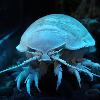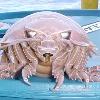

The underside of a male Bathynomus giganteus, a species of giant isopod captured in the Gulf of Mexico in October 2002. Tags: Giant Isopod View |
Here s a shot of one in the wild Here s another photo of one Meanwhile someone with a weird sense of humour posted this photo which allegedly portrays a bunch of juveniles tucking into a bag of Doritos I d love to know Tags: Giant Isopod View |
emily boof perk emily Booth Sep 26 2007 11 36 PM instead of turkey this year mumsalbes is making this its less cooking time Tags: Giant Isopod View |
|||||||||
Bathynomus genus_authority = A. Milne-Edwards (Alphonse Milne-Edwards), 1879 subdivision_ranks = Species subdivision = Bathynomus affinis Bathynomus decemspinosus Bathynomus doederleinii Bathynomus giganteus Bathynomus immanis Bathynomus kapala Bathynomus miyarei Bathynomus pelor Bathynomus propinquus
A giant isopod may be one of approximately nine species of large isopods (crustaceans related to the shrimp and crabs) in the genus Bathynomus. They are thought to be abundant in cold, deep waters of the Atlantic (Atlantic Ocean). Bathynomus giganteus, the species upon which the generitype (biological type) is based, is the largest known isopod and is the one most often referred to by the common name "giant isopod".
French (France) zoologist (zoology) Alphonse Milne-Edwards was the first to describe the genus in 1879 after fishing a juvenile male B. giganteus from the Gulf of Mexico; this was an exciting discovery for both scientists and the public, as at the time the idea of a lifeless or "azoic" deep ocean had only recently been refuted by the work of Sir Charles Wyville Thomson (Charles Wyville Thomson) and others. Females were not recovered until 1891.
Giant isopods are of little interest to most commercial fisheries (fishery) owing to the typical scarcity of catches and because ensnared isopods are usually scavenged beyond marketability before they are recovered. However, in northern Taiwan and other areas, they are common at seaside restaurants, served boiled and bisected with a clean lateral slice. The white meat, similar to crab or lobster in texture, is then easily removed. The species are noted for resemblance to the common woodlouse or pill bug (Armadillidium), to which they are related. The few specimens caught in the Americas with baited traps are sometimes seen in public aquaria (aquarium).
Regnum: Animalia
Phylum: Arthropoda
Subphylum: Crustacea (Crustacean)
Classis: Malacostraca
Ordo: Isopoda
Subordo: Cymothoida
Familia: Cirolanidae



